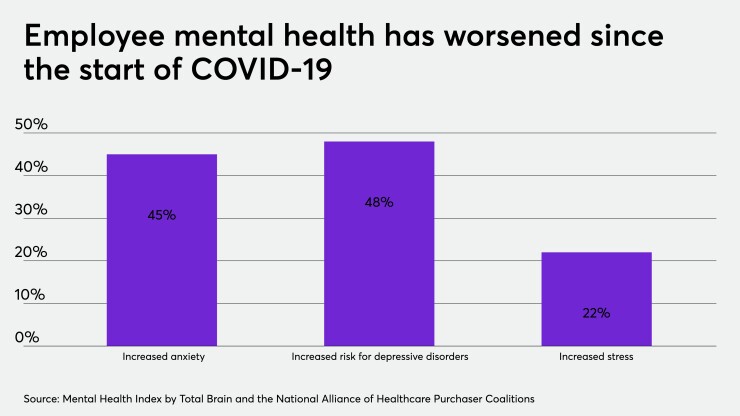“Are you ok?”
Many of us have asked our loved ones, friends and coworkers this question over the past 18 months as we’ve dealt with the trauma and fear of the COVID-19 crisis. As mental health
Since the start of the pandemic, there has been a 93% increase in people seeking treatment for depression and a 63% increase for those seeking help for anxiety, according to Mental Health America. Stress and burnout continue to rise, with more than three-quarters of the workforce
Read more:
At the same time, there is increased optimism around an end to the pandemic. As states reopen and vaccination rates continue to creep up, many are embracing a return to the way things once were. But while it seems like the clouds have parted on a dark 2020, the hard work has only just begun, says Russell Glass, CEO of

“It’ll be a year ‘post-pandemic’ for the mental health issues to get back to the pre-pandemic baseline,” Glass predicts. “There's going to be a long tail of mental health issues as we come out of the pandemic because the reasons that lead to these mental health increases are still there.”
Ginger has been on the front lines of helping millions of people
Glass sat down with EBN to discuss the expected long-tail of mental health issues we’ll face post-pandemic, the future of mental health care and what employers can do now — and in the months ahead — to combat the stigma around mental health.
Read more:
There’s this two-sided feeling right now, of everyone being excited to return to normal and the reality that mental health is still declining and a lot of people are still struggling. What are some of the reasons for this?
The pandemic is a perfect storm of mental health — loneliness and social isolation leads to depression, which leads to anxiety around the uncertainty of when things are
Now it’s uncertainty about, “Am I going to have to start commuting again? Are my children going back to school in the fall? I’m vaccinated but my coworkers aren’t.” All of these things still exist and are shifting and morphing.
Are employers prepared for this?
We've been talking about this for a little while, and I think that our employers are pretty well prepared. The acceleration of adoption of
Why is telehealth a more beneficial treatment model than a more traditional approach?
In most cases, you don't need somebody to be physically there to get tremendous value. In fact, we see a lot of evidence that not having to get in a car and go to an office,
The goal is ultimately, can we get society to the point where everybody understands the self care routines that work for mental health in the same way that everybody understands that exercise is important for physical health.
At Ginger, our adoption rates increased 350% during the pandemic. Forty percent of our population has clinical levels of anxiety and depression. You're just dealing with the vast majority of the population who has a need, and services like Ginger can be there for them in minutes, 24/7. They're connected with a behavioral health coach and can start a simple chat, but then we can navigate those members effectively to the right level of care.
Read more:
What are some other ways employers should be investing in employee well-being as we head into a post-pandemic work world?
It's important to recognize that not everybody's going to be in the same place, and some people are going to have tremendous anxiety
Despite the challenges and uncertainty still ahead, do you feel hopeful about the conversation around mental health and where we’re at?
I am optimistic. The less stigmatized this is, the more people can talk about it and get support early. The earlier you get support in your journey, right before it's clinical, before it's acute, the easier it is to resolve and self-manage your mental health. And that's the goal, right? The goal is ultimately, can we get society to the point where everybody understands the self care routines that work for mental health in the same way that everybody understands that exercise is important for physical health. I'm optimistic that we are heading in that direction as a society.
But, I have concerns because the mental health system is so fundamentally broken that just de-stigmatization and getting more people into the system isn’t going to go well. So there’s going to be a period of time, as more and more people access care, that wait times are going to be longer and resources are going to be hard to find. That’s why solutions like Ginger and others are going to be super important, and it’s important that benefits leaders are thinking about this and taking the time to understand what the needs are and then communicating that to employees. It’s not a “If you build it, they will come,” type of thing. You have to talk to employees about these resources, enforce that the company wants them to be used and reinforce that executives believe in it.






